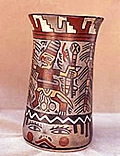Welcome to
Inca Xpress Peru
Tarapaca 226
Miraflores
LIMA18 - Peru
Tel: 51-1-4479519
info@perutravel.org
- Home Page
- Testimonials
- Peru Flights
- Peru Hotels
- Peru Buses
- Alas Peruanas
- Hotel Alegria
- Contact Us!
- We are...
- Contact us
- Testimonials
Linking Peru
- Peru Official
- Prom Peru
- Peru News
- Peru Weather
- Peru Export
- Peru Maps
- Lima Airport
- Lonely Planet
- Rough Guides
- Photo
Gallery
Our
Organization
Related Sites
Machu Picchu, Los Andes, Peru
Buy this Art Print at AllPosters.com
Call us to our
24/7 number:
51-1-97290059
or
Office hours
1-305-433-2528
Our Best Tours
- Colors of Peru
- Titikaka Brezes
- Inca's Land
- Quick Peru
- Water Colors
- Andean Route
- Classic Peru
- The Lost City
- Mythical Peru
- Secret Route
- The best of Peru
- Northen Peru
Peru Treks
Peru Rainforest
Cusco | Puno | Arequipa | Paracas| Ica | Nazca |Lima | Iquitos | Puerto Maldonado
Lima,
| ...(coming from) The symbols may have served as special enclosures for religious ceremonies. How were they built? Straight lines can be made easily for great distances with simple tools. Two wooden stakes placed as a straight line would be used to guide the placement of a third stake along the line. One person would sight along the first two stakes and instructs a second person in the placement of the new stake. This can be repeated as many times as needed to make an almost perfectly-straight line miles in length. The symbols were probably made by drawing the desired figure at some reasonable size, then using a grid system to divide it up. The symbol could then be redrawn at full scale by recreating the grid on the ground and working on each individual square one at a time. Recently two researchers, David Johnson and Steve Mabee, have advanced a theory thin the geoglyphs may be related to water. The Nasca plain is one of the driest places on Earth, getting less than one inch of rain a year. Johnson, while looking for sources of water in the region, noticed that ancient aqueducts, called puquios, seemed to be connected with some of the lines. Johnson thinks thin the shapes may be a giant map of the underground water sources traced on the land. Mabee is working to gather evidence that might confirm this theory. Other scientists are more skeptical, but admit that in a region where finding water was vital to survival, there might well be some connection between the ceremonial purpose of the lines and water. Johan Reinhard, a cultural anthropologist with the National Geographic Society, found that villagers in Bolivia walk along a straight pathway to shrines while praying and dancing for rain. Something similar may have been done in the ancient Nasca lines. The lines at Nasca aren't the only landscape figures Peru boasts. About 850 miles south of the plain is the largest human figure in the world laid out upon the side of Solitary Mountain. The Giant of Atacama stands 393 feet high and is surrounded by lines similar to those at Nasca. Along the Pacific Coast in the foothills of the Andes Mountains is etched a figure resembling a giant candelabrum. Further south, Sierra Pintada, which means "the painted mountain" in Spanish, is covered with vast pictures including spirals, circles, warriors and a condor. Archaeologists speculate thin these figures, clearly visible from the ground, served as guideposts for Inca traders. |
|
Privacy Policy | Contact Us |Inca Xpress Peru © 1291 Larco Ave. Miraflores Lima 18 Tel: 51-1-4455889, 51-1-996992336 1989 - 2006






